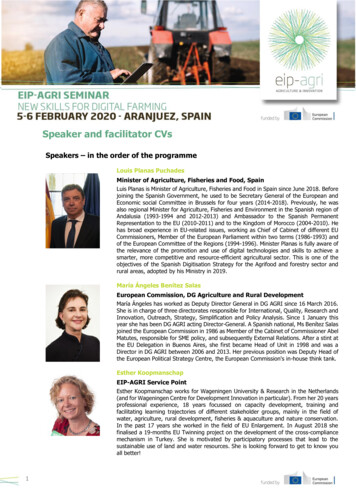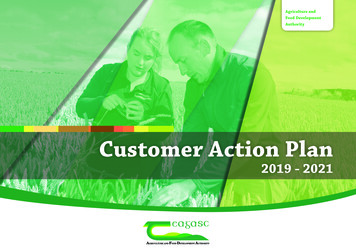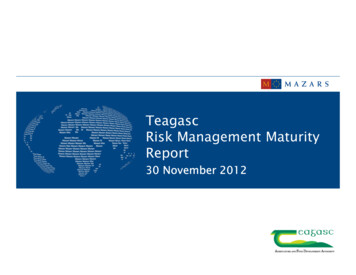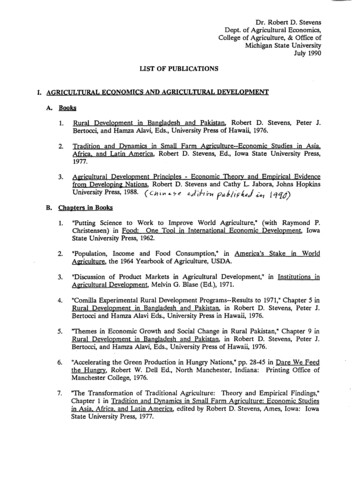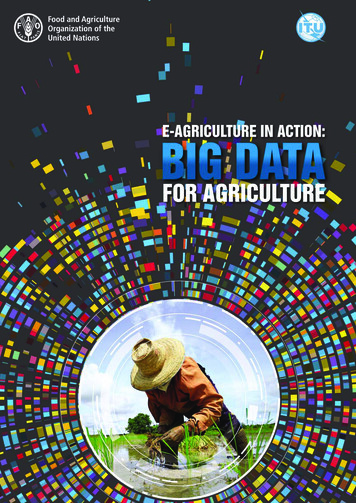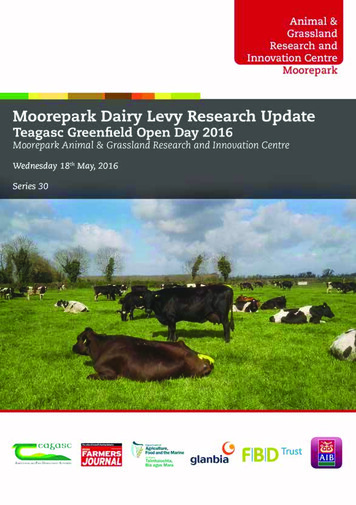
Transcription
Page 1
FIND OUT ALL THE WAYSWE’RE BACKING FARMERSCONTACT OUR DEDICATED AGRI TEAMANNE FINNEGAN,Head of Agri SectorCall: 01 6411974Email: anne.m.finnegan@aib.ieAIB BankcentreDONAL WHELTON,Agri AdvisorCall: 086 4146550Email: donal.j.whelton@aib.ieAIB BandonDIARMUID DONNELLAN,Agri AdvisorCall: 086 4621355Email: diarmuid.p.donnellan@aib.ieAIB O’Connell St, LimerickNOREEN LACEY,National Agri BusinessDevelopment ManagerCall: 086 3817533Email: noreen.p.lacey@aib.ieAIB High St, KilkennyBRYAN DOOCEY,Agri AdvisorCall: 086 8221313Email: bryan.p.doocey@aib.ieAIB 66 South Mall, CorkCHRIS NOLAN,Agri Sector SpecialistCall: 056 7722089Email: chris.p.nolan@aib.ieAIB High St, KilkennySHANE MCCARTHY,Agri Sector SpecialistCall: 021 4276811Email: shane.p.mccarthy@aib.ieAIB 66 South Mall, CorkEAMONN O’REILLY,Agri Advisor Team LeaderCall: 087 2517806Email: eamonn.m.o’reilly@aib.ieAIB MullingarPATRICK O’MEARA,Agri Advisor Team LeaderCall: 086 0229247Email: patrick.j.o’meara@aib.ieAIB NenaghPATRICK BUTTERLY,Agri AdvisorCall: 086 3831576Email: patrick.p.butterly@aib.ieAIB ArdeeLIAM PHELAN,Agri AdvisorCall: 086 0231700Email: liam.p.phelan@aib.ieAIB WicklowBARRY HYLAND,Agri AdvisorCall: 086 3831661Email: barry.l.hyland@aib.ieAIB CavanJOHN FARRELL,Agri Sector TeamCall: 01 6414001Email: john.a.farrell@aib.ieAIB BankcentreSHANE WHELAN,Agri Sector TeamCall: 01 6411437Email: shane.g.whelan@aib.ieAIB BankcentreTADHG BUCKLEY,Agri Advisor Team LeaderCall: 086 1706528Email: tadhg.g.buckley@aib.ieAIB MallowWE’REBACKING BRAVE#backedbyAIBAllied Irish Banks, p.l.c. is regulated by the Central Bank of Ireland.BRANCH. PHONE. ONLINE.
Moorepark Dairy LevyResearch UpdateTeagasc Greenfield Open Day 2016Animal & Grassland Researchand Innovation Centre,Kilkenny Greenfield Open DaySponsored by A.I.B.Wednesday 18th May, 2016Series 30Page 3
Teagasc Greenfield Open Day 2016Table of ContentsForeword 5Patrick O’MearaIntroduction 6Pat DillonThe Greenfield Dairy Farm - Financial Update May 2016 8Laurence Shalloo, James O’Loughlin, Abigail Ryan, Tom Lyng and Eoghan FinneranHerd performance update of the Greenfield Dairy Farm (2010-2016) 19Abigail Ryan, Padraig French, Tom Lyng and Eoghan FinneranGrass DM production and soil fertility update-Greenfield Dairy Farm (2010-2016) 37Abigail Ryan, Padraig French, Tom Lyng and Eoghan FinneranHelping people to perform – The Greenfield experience 45Paidi Kelly, Marion Beecher, Abigail Ryan, Tom Lyng and Eoghan FinneranWorking smarter not harder - The Greenfield experience 55Abigail Ryan, Paidi Kelly, Pat Dillon, Tom Lyng and Eoghan FinneranCoping with milk price volatility 63Laurence Shalloo, Liam Hanrahan, Tom O’ Dwyer and French PadraigManaging through a Downturn 70Padraig French, Tom O’Dwyer and Fintan PhelanManaging through 2016 73Patrick O’MearaNotes 76Page 4
ForewordPatrick O’MearaAIB Agri AdvisorAIB are delighted to collaborate with Teagasc on this key initiative whichis aimed at helping farmers to cope with low milk prices in 2016. Lookingahead, we are all well aware that 2016 will be a challenging year for manyin the sector.Some dairy farmers have already started to experience cashflow pressure andmore are likely to do so over the coming months. If you are experiencing, orexpect to experience cashflow difficulties, it is important to remember thatthere are a number of options available to you, and industry stakeholders(including your local bank manager) to support you and your farm businessthrough this period of short term difficulty.Events such as today, are important for the industry and provide an idealforum in which farmers can share their own experiences and learn fromeach other. I want to reassure you of our commitment to the sector and Iwould encourage you to approach AIB at an early stage to see how we canassist you and your family, if support is required. A number of my colleaguesare here today, and are available to discuss how best we can support yourfarming needs.While the short-term outlook for many of our commodities is less favourable,we maintain a positive medium-to-long term outlook for the sector overall.Finally, I would like to congratulate all involved in the Greenfield projectto-date. I want to thank all contributors to this booklet and hope all whoattend this open day have an enjoyable and informative experience whereyou attain some valuable insight which will be of benefit to you and yourfarming business through 2016.Page 5
Teagasc Greenfield Open Day 2016IntroductionPat DillonHead of Animal & Grassland Research and Innovation Programme, Teagasc,Animal & Grassland Research and Innovation Centre, Moorepark, Fermoy, Co. CorkThe objective of this Open Day is twofold; firstly to update dairy farmers onboth physical and financial performance of the Greenfield Dairy Farm overthe last seven years; secondly to help guide dairy farmers on how best tocope with the low milk price in 2016.In 2009, Teagasc in conjunction with key stakeholders (Irish Farmers Journal,Department of Agriculture, Fisheries and Food, Glanbia, FBD Trust and AIB) setup the Greenfield Dairy Farm. The objective was to demonstrate the setup,operation and financial performance of a large grass based GreenfieldDairy Farm. Additionally, to identify the risks and demonstrate the riskmanagement strategies associated with dairy expansion. The project is nowin its 7th year and the main outcomes for the first seven years of the projectare: Dairy expansion can be time consuming & adds severe workload if notcarefully planned - seek help & advice In the short term prioritise investment towards areas of maximumreturn- cows, grazing infrastructure and soil fertility Cash flow management during conversion & during the initial years ofproduction is critical to the success Herd performance can be sub-optimal in the initial years; however willincrease with the use of high EBI genetics and increase grass productionand utilisation Seek healthy high EBI dairy stock from herds with a proven herd healthhistory; have a vaccination plan Highly skilled staff is crucial in operating an efficient large scale dairyfarmIrish milk prices have become increasingly volatile in recent years due toglobal market turbulence arising from tight supply/demand conditions;this is likely to continue into the future. This requires a resilient systemof milk production i.e. a low cost base to insulate the business from priceshocks and allow family based farms to generate sufficient funds in highermilk price times to meet family commitments and finance expansion.Additionally, the system must have sufficient tactical flexibility to overcomeunanticipated events that can lower short term profitability (e.g. cold wetspring etc.). The following are the key components of resilient dairy systems: High EBI genetics: Herd must be both productive and fertile High grass production and utilisation per hectare: Farm profitability ( /ha) is closely linked to the quantity of grass utilised per hectare (tonnesDM/ha).Page 6
Resource efficient and sustainable intensification: Dairy farm systemsmust continue to be highly resource efficient per unit of input whileminimising undesirable outcomes (greenhouse gas emissions) Optimum stocking rate: The optimum stocking rate will depend on thelevel of grass production (tonnes DM/ha); a long grazing season withminimal ( 500 kg DM) purchased feed supplementation.The support of all the stakeholders in the project is greatly acknowledged. Allinformation pertaining to the Greenfield Dairy Programme as well as weeklyupdate is available on the Greenfield website at: http://www.greenfielddairy.ie/.Page 7
Teagasc Greenfield Open Day 2016The Greenfield Dairy Farm Financial Update May 2016Laurence Shalloo¹, James O’Loughlin¹, Abigail Ryan¹, Tom Lyng²and Eoghan Finneran²¹Teagasc, Animal & Grassland Research and Innovation Centre, Moorepark,Fermoy, Co. Cork; ²Farm Staff Team, Greenfield Dairy Farm, KilkennySummary A key focus on the Greenfield Dairy Farm is to increase grass growthand to match the overall grass growth with the herd demand in orderto produce milk with the lowest cost in a sustainable fashion. The high fixed costs on the farm related to full land leasing, labour andbank payments result in overall costs of production that were 37cpl in2015, but that have dropped from a high of 42cpl in 2014. Increasing the resilience of the Greenfield business in the contextof volatile milk price is a key driver of strategies on the farm. Thesestrategies include a reduction in the farm base breakeven milk price,the creation of a cash sink fund and participation in the Glanbia fixedmilk price schemes. In 2016, it is anticipated that the farm will generate a cash deficitthat has been identified through the budgetary process; this will bemonitored and managed throughout 2016.IntroductionThe Greenfield Dairy Farm is now in its seventh year (almost half way throughthe 15 year term). This is a good opportunity to present how the overallfarm has performed over this period and to look forward to the future; inparticular to discuss how the farm will deal with the very difficult milkprice conditions anticipated for 2016. To start this process it is importantto remind ourselves of the circumstances that the farm was set up in 2009.Business plans for this project were put together and refined on a number ofoccasions between 2007 and 2009. Up to 2009 the plans that were developedwere based on a milk price of 28 cpl with an investment of approximately 1.8 million. These plans were dramatically changed as a result of theexperiences of 2009 where milk price averaged approximately 23 cpl as wellas being a difficult year on heavy soils. As a result of this experience, thebusiness plans was rebuilt based on a milk price of 24 cpl with an overallinvestment of 1.1 million. The agreement between the three shareholders(Glanbia, Phelan family and Farmers Journal Trust) was secured in May 2009and planning permission was finally secured in November 2009. BetweenNovember 2009 and February 2010 all winter housing, slurry storage andmilk harvesting facilities were constructed. The farm has been operationalsince February 2010 with 6 full lactations now complete. This paperdescribes the farm under a number of headings;Page 8
Farm performance Financial performance Dealing with price volatility on the Greenfield Dairy Farm Managing through 2016Farm PerformanceThe original farm business plan for the Greenfield Dairy Farm can beaccessed at (http://www.greenfielddairy.ie/node/103). The plan was based onminimising capital investment on the farm while expanding cow numbersin order to maximise grass utilisation (Table 1). Cow numbers were projectedto increase from 250 in Year 1 (2010) to 350 in Year 10 (2019). Milk solidsyield per hectare was projected to increase from 760/ha in Year 1 (2010) to1300kg/ha in Year 10 (2019). Cow numbers (including in calf heifers) on thefarm on the first of January were 250 in Year 1 (2010), 307 in Year 2 (2011)306 in Year 3 (2012), 346 in Year 4 (2013), 332 in Year 5 (2014) and 334 inYear 6 (2015). Milk solids/hectare was 737 kg/ha in Year 1 (2010) and 962 kg/ha in Year 2 (2011), 983 kg/ha in Year 3 (2012), 1,090 kg/ha in Year 4 (2013),1,079 kg/ha in Year 5 (2014) and1,089 kg/ha in Year 6 (2015). Grass growthhas increased from 12 t DM/ha in 2010 to 13.9 t DM/Ha in 2015. However,the farm is prone to drought, which was observed on the farm in 2013 withgrass dry matter production running at just over 10 t/ha resulting in asignificant deficit in feed supply and adding substantial cost to the overallbusiness (feed costs in 2013 circa 103,000 versus 2014 circa 20,000).Table 1. Farm level physical projections for the Greenfield Dairy Farmin the original business plan when compared to what was realised inthe first six yearsCowGrassProteinFatMSMSYearCalving growth%%Kg/hakgno.’skg/ha2010 Projected2509,2053.413.9076191,0812010 Actual25012,0003.544.2873783,1832011 Projected27010,3863.413.90846101,1432011 Actual30711,3833.524.41962108,5152012 Projected29011,6673.423.93933111,5042012 Actual30611,8003.574.62983110,8812013 Projected30012,4623.463.99999119,3572013 Actual34610,0273.634.461,090123,0052014 Projected31013,2163.484.031,049125,3932014 Actual33213,2113.694.671,079121,6782015 Projected32014,0593.494.071,101124,4252015 Actual33413,9013.874.641,089130,626* Land area has increased in 2014Page 9
Teagasc Greenfield Open Day 2016Financial performanceOver the first six years of this project the farm has performed substantiallyahead of what was included in the original budget. This has largely beendue to the fact that the milk price in which the farm is operating issubstantially better than was originally set out in the budget. Table 2 showsa summary between actual and projected financial performance for thefarm over the first six years. The farm has generated substantial profit overthe six years. Debt servicing for the farm was based on interest only for thefirst two years with capital and interest being paid since 2011. One of thekey problems for most start up or expanding dairy businesses is aroundgenerating positive cash flows in the initial years. While a business may beprofitable, this profitability may not result in positive cash flow. However,within the Greenfield Dairy Farm both cash flows and profitability havebeen positive over the first six years of the project. In the original businessplan the farm was not expected to be profitable until year four and in effectthe fact that the farm has been profitable from year two, has meant that theaccumulated profits are significantly more than was originally considered.A number of metrics are used in addition to profitability to evaluate thefinancial performance of the Greenfield Dairy Farm. These include returnon investment (ROI) and return on equity (ROE) and overall cash flow. In theGreenfield Dairy Farm, both ROI and ROE calculations are completed for thefarm annually and compared to projected figures. On average the ROI forthe farm is running at just under 9% when year one is excluded from thecalculation which corresponds to approximately 5% above the cost of funds.In relation to ROE, the farm is running at 18% for the years from two toseven. It is anticipated that the return on equity will drop over time as debtis repaid and as the equity proportion of the overall investment increases.Both ROE and ROI returns for the farm to date would compare favourablywith an investment that may be made in competing investments off farm.Page 10
Page 11FarmReceipts( )TotalCosts ( )NetProfit ( )ROIROESurplusCash ( 22387,462 397831 445,888 537,640 460,015 527,654 454,996 608,626 462,432 593,392 463,984 551,706380,397 397,949 419,132 567,323 458,657 573,666 490,029 725,910 512,089 690,090 534,140 600,028ProjectedTable 2. Farm level financial projections for the Greenfield Dairy Farm in the original business plan when comparedto what was realised in the first six yearsYear 1 (2010)Year 2 (2011)Year 3 (2012)Year 4 (2013)Year 5 (2014)Year 6 (2015)
Teagasc Greenfield Open Day 2016Dealing with price volatility on the Greenfield Dairy FarmThe Greenfield dairy business seeks to reward all of the resources employedwhile at the same time generating a substantial return for the shareholdersinvolved in the project over the 15 year life of the project. One key concerncentres on the fact that the overall cost structure has been well aheadof what was originally planned which is something that requires carefulconsideration to ensure that the business is viable even at lower milk prices(similar to what the industry is experiencing now). There are a number of key areaswhere the farm has had substantially higher costs than originally budgeted.These areas include overall farm borrowings, heifer rearing, fertiliser costs,on-going maintenance and development, standoff pad maintenance andbark mulch costs and finally purchased feed requirements. This results inthe farm having a relatively high cost of production (37c/l) in 2015 and istherefore exposed to the variances of milk price volatility. This was realisedearly in the project and a risk management plan was put in place to ensurethat the business was viable even a low milk prices. This plan encompassesa whole range of strategies that go to the very ethos of the business andeffects all of the decisions made on the farm on both a long and short termbasis. The strategies employed can be broken into three main headingsreducing the breakeven milk price, managing cash to create a reserve whenmilk price is poor and availing of the Glanbia fixed milk price schemes.Breakeven milk priceThere has been a focus on the farm to reduce the cash breakeven milk price(i.e. the base milk price 3.3% P and 3.6% F where all of the cash commitments canbe made for the farm including capital repayments). Over the past number ofyears, the breakeven milk price has dropped from just over 30c/l (base priceexcluding vat @3.3% P and 3.6%F) to a budgeted breakeven price in 2016 of24.8c/l (base price excluding vat @3.3% P and 3.6%F) and an actual breakevenprice in 2015 of just under 24c/l. Below this base milk price, the farm willgenerate a cash deficit. The factors associated with this reduction canbroadly be characterised by three main features;Reducing costs in a number of key areasTotal costs on the Greenfield Dairy Farm were 537,640, 553,511, 608,626, 593,392, 551,706 in 2011, 2012, 2013, 2014 and 2015, respectively withbudgeted costs for 2016 estimated to be 580,674. As can be seen from thesenumbers there was a big increase in total costs in 2013 driven by in generalpoor grass growing conditions throughout the year on a farm that hadlimited soil organic matter and therefore was conducive to drought. Therehas been a focus on the farm to reduce total costs based on a focus on anumber of key aspects of the business and this has resulted in total costsreducing from 608,626 to 551,706 between 2013 and 2015. Even thoughover this period some of the costs on the farm increased (e.g. contractor 34,277 to 57,670, veterinary costs 20,417 to 24,206, bank interest 18,000to 24,000 and land rental 52,998 to 65,446). There was a focus placed on anumber of key areas to reduce costs by maximising the conversion of grassto milk, minimising supplementary feeding, breeding a cow for the systemand operating with minimal investment in depreciating assets. Across thePage 12
farm there have been areas that have been targeted to reduce costs since2013 (e.g. purchased concentrate 61,883 to 15,373, purchased forage 42,735to 2028, contract rearing 71,171 to 68,742, repairs and maintenance 31,634to 6,086). With some costs increasing but with a major overall reductionin costs on farm from 608,626 to 551,706 there is a reduction in the totalcosts per litre from 41.4c/l to 37.6c/l or 3.8c/l based on the 2013 milk output.Increasing stocking rates to match increased grass growthOver the past number of years there has been a consistent increase in grassgrowth (except 2013) which has been matched with a consistent increasein the number of cows managed on the farm. This trend will continue asgrass growth levels increase from the farm. When compared against theaverage of the first three years of the business, the farm is now carrying astocking rate that is 13% higher than was the case at the start of the venture.Virtually this entire higher stocking rate is being facilitated by increasedgrass growth from the farm. The additional milk sold as a result of theincreased stocking rates is helping to reduce the overall costs on the farm. Itis however important to note that the benefit from increasing the stockingrate only lasts while the additional stocking rates are being facilitated byincreased grass supplies. It is extremely difficult to disentangle the benefitsfrom increasing output from the farm from targeting areas to reduce costsacross the farm as a whole.Increase milk solids concentrationsMilk solids concentrations have increased from 3.54% Protein and 4.28%Fat in Year one of this business to 3.87% Protein and 4.64% Fat by 2015. Thiswas as a result of a strong focus on grassland management and breedingstrategies within the herd. This increase in solids is worth 3.4 c/l at a milkprice of 29 c/l but even more importantly it is worth 2.8 c/l at a milk price of23 c/l and has a substantial effect on reducing the milk price point at whichthe farm still generates a positive cash flow (breakeven) and substantiallyreduces the exposure of the business.Between the three strategies operated to increase the resilience of the farmthere has been a reduction of the breakeven point of the farm of between6.5 and 7.0 c/l. In effect, the farm would have required a base price of over30 c/l in 2013 whereas the corresponding figure for 2015 is closer to 23 c/l at3.3% Protein and 3.6% Fat just to breakeven.Fixing milk priceThe Greenfield Dairy Farm has availed of most (except 2013) of the Glanbiafixed milk price schemes that have been offered. Each year there aredifferent schemes offered by Glanbia based on deals done with customers.The Greenfield Dairy Farm has had different levels of milk locked into thedifferent schemes each year based on availability and the amount of eachscheme that was sought. There has been 0%, 15%, 27%, 24%, 25% and 23%locked into the fixed price contract in each year from 2010 to 2015 andthere is approximately 23% locked between two fixed price schemes (20142017 and 2015-2018) for 2016 (Table 3). Overall in the fixed pricing schemesthat the Greenfield Dairy Farm has been locked into, there has been a netbenefit of 10,455 up until the end of 2015 and a projected net benefit ofPage 13
Teagasc Greenfield Open Day 2016 36,457 at the end of 2016. The net effect in each year has been - 3,891, 10,099, - 15,982, - 2,257, 22,487 for 2011, 2012, 2013, 2014 and 2015 andbased on current projections for 2016 it is estimated that net benefit will be 26,003 based on an average manufacturing price of 21.8c/l excluding vatand any share bonus. The schemes that have operated to date while costingmoney in a high milk price year (when the farm is in the best position to sustaina cost), have provided a cushion in years when they are needed (poor milkprice). It is projected that in 2016 that the fixed price schemes will be worthapproximately 1.9 c/l. In the Greenfield Dairy Farm, this scheme has bothcushioned the farm in a poor milk price year and has actually increased theoverall payout over the six years to the end of 2016.Managing cashAs there is a return made to all cost resources employed in the GreenfieldDairy Farm in Kilkenny, the farm has a relatively high cost of production.Total costs per litre in 2015 were just over 37 c/l. While as previouslymentioned, there has been considerable movement on reducing thebreakeven base price from over 30 c/l to where it currently stands, therewas also a requirement to generate a reserve or sink fund for the farmto deal with milk prices that we are experiencing in years such as 2016.Therefore, when milk price was high in the past a sink fund was createdin order for the farm to be in a position to manage reduced milk prices. In2011 and 2013 there was a combined sink fund of 125,000 created for thefarm to help reduce the exposure. This fund has to date been untouchedand is there if milk price was to drop further than projected for 2016. Thecreation of the fund was made possible by a strong focus on cost controland discipline to generate the sink fund and was facilitated by the taxationstructure of the Greenfield Dairy Farm (liable for corporation tax).Managing through 2016At the start of each year a process on the Greenfield Dairy Farm is gonethrough which involves putting together a detailed budget based on firstprinciples for the farm operation. This occurs between late December andearly January and may involve a number of permutations and iterationsof the figures based on discussions with the Greenfield Dairy Farmmanagement team. This process uses the most realistic assumptions at thetime for inputs across all aspects of the business for the year and includesassumptions around milk price, milk yields, milk solids, grass growth,requirements for supplementary feeds, etc. Generally a prudent approachis taken around this process, thus ensuring that the farm has the scope tooutperform the budget each year. This process was completed this year withan assumption that the base milk price received on the farm would be 24 c/lplus vat @ 3.3% Protein and 3.6% Fat based on an average manufacturingprice of 21.8 c/l and 23% of the milk price fixed. It is anticipated that therewill be 450 kg of concentrate fed to each cow in the herd and that there willbe a requirement to purchase approximately 150 t DM of forage. The farmperformance projections are based on 335 cows on the farm in June eachof which producing approximately 400 kg of milk solids. The assumptionsincluded for 2016 are based on the previous farm performance and by andPage 14
large there is little deviation of the projected management for 2016 relativeto years of high milk price, albeit the same can be said for the years wherethe milk price is high (by and large the system does not deviate). Table 4 showsthe projections for the farm for 2016 based on the above assumptions andit can be seen that based on these assumptions that the farm will havea relatively small negative cash flow (relative to the size of the farm and theprojected milk price). This budget will be continually updated throughout2016 and if required remedial action will be taken to reduce the cash deficit.Options include to reduce the stocking rate on the farm, reduce the numberof replacement heifers at the contract rearers, reduce the spend on farmmaintenance, etc.Page 15
Page 8,6691,316,4772011Supply 28.1438.4632.3741.9644.2534.8938.69Base c/lTable 3. The effect of fixed milk price schemes as effecting the performance of the Greenfield Dairy 891Diff Teagasc Greenfield Open Day 2016
Table 4. Cash flow and profitability budget for the Greenfield DairyFarm 2016Gross outputSalesMilkLivestockOther e.g. Forage salesTotalPurchasesLivestockTotalInventory /Gross OutputVariable costsContractingSilage, hedegecutting, slurry spreadingAIStraws, technician and breeding costsAnimalTagsBeddingWoodchip, StrawDairySupplies, Milk recordingFeedForage and concentrateFertilizersN.P.K and LimeGrassSeeds and SpraysHeiferFeed and contract rearing related costsLeviesLeviesVeterinaryAll health related costsTotal Variable costsGross ,220 /ha /kgMS 37.06600.050.46600.050.461650.151.294,861 4.32 37.8943,230 35714,640 1211,507126,9505712,183 10164,050 52951,217 4231,6461476,142 6297,2986024,250 200303,113 2,505285,107 70.003.600.000.0037.0637.60-0.54Fixed costsAdminstrationAccountancy and consultancyBankFees and InterestEnergyElectricity and FuelInsuranceLabourAll staff related costsMachineryRunning including repairs/maintenanceRepairs & MainGeneral farmDepreciationMachinery and BuildingsLandRental and LeaseTotal Fixed CostsTotal CostsNet ProfitProfit before Rent & BankTaxationCapital repaymentsCapital ExpenditureSFPCapital InflowsCash OutflowCashflow 004,7564,825-69Page 17
Teagasc Greenfield Open Day 2016ConclusionThe Greenfield Dairy Farm has made significant progress in increasing itsresilience to price volatility over the past number of years through reducingthe farm breakeven base milk price. This focus has resulted in the farmbecoming more profitable and has reduced the exposure of the businessto price volatility. The focus on the farm will centre on the continuedinvestment in areas that will increase pasture production from the farmand matching the increased grass growth with increased stocking rates,ultimately increasing the farm productivity from grazed grass.Page 18
Herd performance updat
Email: bryan.p.doocey@aib.ie AIB 66 South Mall, Cork SHANE MCCARTHY, Agri Sector Specialist Call: 021 4276811 Email: shane.p.mccarthy@aib.ie AIB 66 South Mall, Cork PATRICK O'MEARA, Agri Advisor Team Leader Call: 086 0229247 Email: patrick.j.o'meara@aib.ie AIB Nenagh LIAM PHELAN, Agri Advisor Call: 086 0231700 Email: liam.p.phelan@aib.ie .
